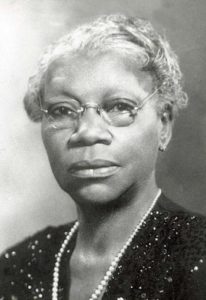
Artemisia Bowden
*Artemisia Bowden was born on this date in 1879. She was a Black school administrator and civil rights activist. Artemisia Bowden was born in Albany, Georgia, to former slaves Milas and Mary Bowden. She was the oldest of four children, and in her early life, she grew up in Brunswick, Georgia. There, she attended Athanasius’ parish school, as her father was an active member of St. Athanasius Episcopal Methodist Church. She was taught how to cook, sew, and play the piano when she was young. Bowden later attended St. Augustine's Normal School in Raleigh, North Carolina, where she graduated in 1900.
Classroom and community life
After graduating from St. Augustine's Normal School in Raleigh in 1900, she became an educator at St. Joseph's Parochial School in Fayetteville, North Carolina. After a year of teaching at St. Joseph's Parochial School, she accepted another position at High Point Normal and Industrial School in High Point, North Carolina. Bowden spent much of her life fighting for equal education and black rights. A few examples of her roles in civic programs were “introducing a Black nursing unit in Robert E. Green Hospital, securing Lindbergh Park for Black residents, and establishing the East Side Settlement House. She continued teaching at High Point for one more year when she received another opportunity.
Career
Bishop James Johnston of St. Philip's Normal and Industrial School in San Antonio, Texas, began a search for a qualified individual to take the position of chief administrator and primary teacher. Bowden accepted the position and arrived in 1902, and as principal, Bowden made many changes to St. Philip's Day School. Under her administration, she divided the departments into a primary and secondary grammar school and a vocational school. In the vocational program, Bowden focused on teaching young women reading, writing, algebra, history, botany, sewing and cooking, and other homemaking skills. In 1907, there was an integration of vocational and industrial skills in public schools, and because the tuition at St. Philip's was high at the time, St. Philip's saw a decrease in the number of students enrolled.
Bowden sought out students from outside of San Antonio and added a Normal Department to prepare elementary school teachers, and by 1908, low enrollment was no longer an issue. 1917 she helped move the school to its current location on the San Antonio East Side. In 1926, Bowden set out to help the school achieve the next level in higher education for her school, junior college status. She fundraised for her school, and with the support of the American Church Institute for Negroes the school was able to obtain "a new main building, which included classrooms, space for boarding students, a gym, music rooms, a dining hall, a handicraft room, and a library." In September 1927, St. Philip's Junior College opened.
During the Great Depression, in 1934, the Episcopal Church and Diocese of West Texas renounced the fiscal responsibilities of St. Philips, leaving Bowden with an impending foreclosure and lost assets. Bowden looked to friends, family, and her community for financial assistance. When her father died, she used $1,000 out of the $2,000 inheritance she received for school obligations such as school supplies and teacher salaries. She also began a campaign to have the San Antonio School Board assume fiscal responsibilities but was rejected several times. On September 15, 1942, the San Antonio School Board accepted St. Philip's Junior College as the first junior black college governed by a city school board. Bowden became its Vice President. 1954, after 52 years of service, she retired with the title of Dean Emeritus.
She is recognized not only for her contributions to the success of St. Philip's College but also for her leadership and success in civic and welfare projects for African Americans in greater San Antonio. Bowden received an honorary degree from Wiley College in 1935 and Tillotson College in 1952 for her civic work. She served as president of the San Antonio Metropolitan Council of Negro Women and founded and served as president of the Negro Business and Professional Women's Club. She founded the Bowden Chapter of Business and Professional Women.” In 1955, Zeta Phi Beta sorority named her woman of the year. The National Council of Negro Women awarded Bowden as "one of the ten most outstanding women educators in the United States." Legacy
She never married but was known to be married to her school and civic duty. She was also known for her confidence. “Miss Esdale Malloy...described her ‘as a person of supreme confidence, one who felt she could overcome any obstacle". Artemisia Bowden passed away on August 18, 1969, in San Antonio. She was cremated and interred in Corpus Christi, Texas. Artemisia Bowden's legacy lives on today and is honored by the San Antonio Independent School District's Bowden Elementary School, the Bowden Administration Building at St. Philip's College, and the University of Incarnate Word's Health and Eye Center. In 2015, she was elevated to sainthood in the Episcopal Church, with August 18 as her saint day.
To Become a School Principal
To Become an Elementary School Teacher